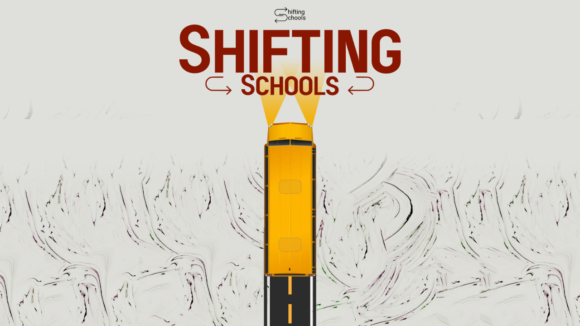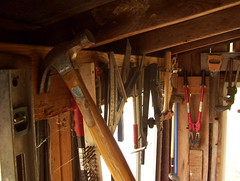
It's not about Web 2.0 it's about learning!
Today I had the pleasure of doing a short presentation for our IB Theory of Knowledge class. I was invited in to give a lesson on how knowledge is changing in the 21st century. My first thought was “How do I tell students knowledge has changed, when they already know that?”
I set up 3 Skype accounts for students to login to and keep notes on. I did not want to only talk about how knowledge is changing I wanted them to experience it. To feel the power of collective note taking, the power of multiple perspectives on a subject or theory. The 3 Skype accounts where for 17 students making them anonymous. I figured that if they were anonymous that the students would fell free to write more about what they were thinking, willing to take a risk and stretch their thinking.
In the end the laptops didn’t have Skype installed (it’s part of our image but these were Science laptops and didn’t have the new image on them). But I did at the same time podcast the conversation (to be posted later) telling students that in this new world of knowledge, not only do you acquire it, but you then publish it for others to use as an information nod as well.
I used George Siemens Connectivism Theory as a starting point and we went from there. I put together a little Wiki page for the students so as they do their homework assignment tonight they have the links that we talked about today.
So here I was in the middle of teaching students about how knowledge has changed. How it is the connections that the Internet allows us to make that is changing knowledge and information acquisition, and at the same time thinking about the conversation that has been sparked by a recent techlearning post of mine.
If you’re out of the loop on the conversation here’s a recap:
1. Fear Factor
2. Teachers & Technology – a rant!
3. Why teachers Don’t Use Web 2.0 – an historical perspective
4. Why teachers Use Web 2.0
5. Stager, Logo and Web 2.0
6. Web 2 is Like Logo?
And now this post.
There are a lot of great quotes that I could take from all of these posts and they have all made me think.
First off….logo? Seriously…I know the program was popular but I never saw it in school. I never knew it was made to be an educational program and I have no experience with it. Now, Stager takes me on a little history of educational technology and what a great lesson, but at the end of the day, like most teachers. I really don’t care. What I want to know is how is this going to affect my teaching and student learning today?
Warlick makes an interesting observation in his Web 2 is Like Logo? post where he finds that neither I nor himself used the phrase Web 2.0 in our posts and it wasn’t until Stager’s post that the conversation shifted to a Web 2.0 focus.
 In my original post I talk about tools, tools that I feel could be using in education. They are not educational tools, but then again neither are Word, Excel, and PowerPoint, but they seem to be used in education a lot. We loaded these tools because if teachers were open to exploring them, we wanted them to feel free to explore, to use, and to change the way teaching happens and knowledge is acquired. Today I was excited to show a teacher just how Skype could be used (or any IM application for that matter). Instant Messaging is not Web 2.0…in fact I think it would pretty much fall under the Web 1.0 heading. But neither is the point. My real point is that this is a tool that students use, that students know, and that I believe if used properly in the classroom could have and impact on student learning…or at the very least student note taking.
In my original post I talk about tools, tools that I feel could be using in education. They are not educational tools, but then again neither are Word, Excel, and PowerPoint, but they seem to be used in education a lot. We loaded these tools because if teachers were open to exploring them, we wanted them to feel free to explore, to use, and to change the way teaching happens and knowledge is acquired. Today I was excited to show a teacher just how Skype could be used (or any IM application for that matter). Instant Messaging is not Web 2.0…in fact I think it would pretty much fall under the Web 1.0 heading. But neither is the point. My real point is that this is a tool that students use, that students know, and that I believe if used properly in the classroom could have and impact on student learning…or at the very least student note taking.
Downes writes:
When I speak to teachers these days, I don’t tell them how to improve the way they teach their students. I talk to them about how they can improve the way they teach themselves.
I think this is where we need to begin. After giving my little talk today to the 11th graders I helped them sign up with our Moodle installation for the class. It was interesting to watch them learn. To watch them help each other out and watch them teach themselves and each other. This came through in Warlick’s Rant as well. You can not introduce these new connectivist tools and not change the way you teach. By connectivist tools I mean a computer with an Internet connection.
It’s not about Web 2.0 it’s about learning! It’s about changing the way we all learn and then as good teachers do take those skills and teach others. If our teachers are still learning in traditional ways they will continue to teach in traditional ways. However if you’ve ever been with a teacher that has learned these new literacy skills, who has embraced them and seen their power like all of us, then they teach them to their students.
We are finishing up our third week of school and the 5th grade teachers who I worked closely with last year have already set all their students up with blogs, are starting to teach RSS and are planning a unit on having their students create blog grading rubrics. Why? Because they see how these new literacies change teaching and learning. They are excited about it and in return the students are too. Some students have blogged every day so far even though they’ve only been given one blogging assignment…and it’s not about blogging…it about writing at this point. One student has written 3 chapters of a story on his blog…that is writing done outside of class, on his own.
 We need to understand how connecting to this wider and deeper body of knowledge changes our classrooms. It’s not about Web 2.0. It’s not about where we were in education, nothing has ever been accomplished by looking backwards. We need to focus on teaching teachers these new literacy skills so they can in turn teach students.
We need to understand how connecting to this wider and deeper body of knowledge changes our classrooms. It’s not about Web 2.0. It’s not about where we were in education, nothing has ever been accomplished by looking backwards. We need to focus on teaching teachers these new literacy skills so they can in turn teach students.
You can not teach that which you do not know! The kids are ready…today after reading Siemen’s Connectivism Theory paper I asked the 11th graders what they thought. One student blurted out “I agree!”
They’re ready…we need to get over our fears, get messy, and get with it or like everyone I’ve quoted here says: School will become irrelevant. And that should be our biggest fear of all.
[tags]David Warlick, Gary Stager, Stephen Downes, Miguel Guhlin, Web 2.0, education[/tags]
Technorati Tags: David Warlick, Gary Stager, Stephen Downes, Miguel Guhlin, Jeff Utecht, Web 2.0,
education







Jeff, I agree with your quote of Stephen’s comment. That statement alone was powerful, forget the other stuff. Of course, there was so much to process in that post and I appreciate you taking it on.
I’m waiting to write about those points later this weekend when I have time to reflect some more.
Best wishes,
Miguel
Jeff,
If you make an argument based on novelty and change — “This is NEW!” — but you don’t understand the history of the subject, and indeed assert that understanding the history is not important, your argument has no foundation.
Thank you, Tom. I agree completely with your comment. How does one know if some idea or concept or tool is “new” if one does not know the history of what came before? Jeff, while I share your enthusiasm for these tools and strategies, I hardly think that any computer with an Internet connection is necessarily a connectivist tool. Mitra’s computer in the hole in the wall (here’s a link: http://blog.genyes.com/index.php/2007/05/24/hole-in-the-wall-can-kids-learn-computer-literacy-by-themselves/) was more connectivist than many of the Internet machines I see that are linked to servers that spit out glorified Web-based worksheets.
Of course it’s about learning. Of course it’s about tools. But it’s also about knowing that none of human history or progress or knowledge comes from a vacuum.
Here’s a link to an article I wrote after being on a panel discussion with Dr. Mitra in Delhi, India.
http://www.districtadministration.com/viewarticle.aspx?articleid=526
[…] Utecht, The Thinking Stick September 6, 2007 [原文链接] [æ ‡ç¾: United States, Visualization, Web 2.0] […]
[…] Utecht, The Thinking Stick September 6, 2007 [原文链接] [æ ‡ç¾: United States, Visualization, Web 2.0] […]
[…] step and the most crucial aspect of 21st Century Literacy is taking classroom learning global. It doesn’t matter which tools we use, as long as we are communicating with a wider audience and learning from our […]
Jeff…great points about Connectivism! I am always looking for ways to encourage teachers in my building to have their students connect with each other and people around the world. You mentioned in your post about some projects and blogs that your fifth grade teachers are doing. Are those blogs public that I could see the types of ideas, thoughts, conversations that are taking place. I am looking for a way to encourage my fifth grade teachers, and this looks to be a good way to see real content in action. Thanks for your help and the posts!